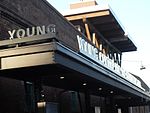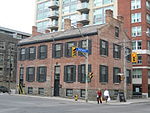Types Riot
The Types Riot was the destruction of William Lyon Mackenzie's printing press and movable type by members of the Family Compact on June 8, 1826, in York, Upper Canada (now known as Toronto). The Family Compact was the ruling elite of Upper Canada who appointed themselves to positions of power within the Upper Canadian government. Mackenzie created the Colonial Advocate newspaper and published editorials in the paper that accused the Family Compact of incompetence and profiteering on corrupt practices, offending the rioters. It is not known who planned the riot, although Samuel Jarvis, a government official, later claimed he organized the event. On the evening of June 8, 9–15 rioters forced their way into the newspaper offices and destroyed property. During the event, Mackenzie's employees tried to get passersby to help stop the rioters. Bystanders refused to help when they saw government officials like William Allan and Stephen Heward were watching the spectacle. When the rioters finished destroying the office, they took cases of type with them and threw them into the nearby bay. Mackenzie sued the rioters for the damage to his property and lost business opportunities. The civil trial attracted substantial media attention, with several newspapers denouncing the government officials who failed to stop the riot. A jury awarded Mackenzie £625 to be paid by the defendants, a particularly harsh settlement. He used the event to highlight abuses of the Upper Canada government during his first campaign for election to the Parliament of Upper Canada, for which he was ultimately successful. Reformers viewed Mackenzie as a martyr because of the destruction of his property and he remained popular for several years. Historians identify the event as a sign of weakening Tory influence in Upper Canada politics.
Excerpt from the Wikipedia article Types Riot (License: CC BY-SA 3.0, Authors).Types Riot
Frederick Street, Toronto
Geographical coordinates (GPS) Address Nearby Places Show on map
Geographical coordinates (GPS)
| Latitude | Longitude |
|---|---|
| N 43.65025 ° | E -79.369138888889 ° |
Address
Frederick Street 160
M5A 3Z4 Toronto
Ontario, Canada
Open on Google Maps











